High-yielding sweet variety of honeysuckle Indigo jam
Honeysuckle Indigo Jam has many positive characteristics that contribute to its growing popularity among gardeners. The new variety is valued for its early ripening of tasty and healthy berries, consistently rich harvest and frost resistance. It is grown both on private farms and on an industrial scale. Those who want to plant this crop and get a decent harvest should familiarize themselves with the rules of its agricultural technology.
Description of the honeysuckle variety Indigo Jam
The variety belongs to medium-ripening crops. Already at the end of June you can enjoy delicious and vitamin-rich berries.
Origin and development
A new large-fruited variety was bred by Canadian breeders. In Russia, it was tested in the Moscow region, after which it received high praise from the country's farmers.
Thanks to its characteristics, Indigo gem honeysuckle quickly became popular and in demand in all regions of the country. In the USA it is one of the top performing crops.
Characteristics, description of appearance, taste
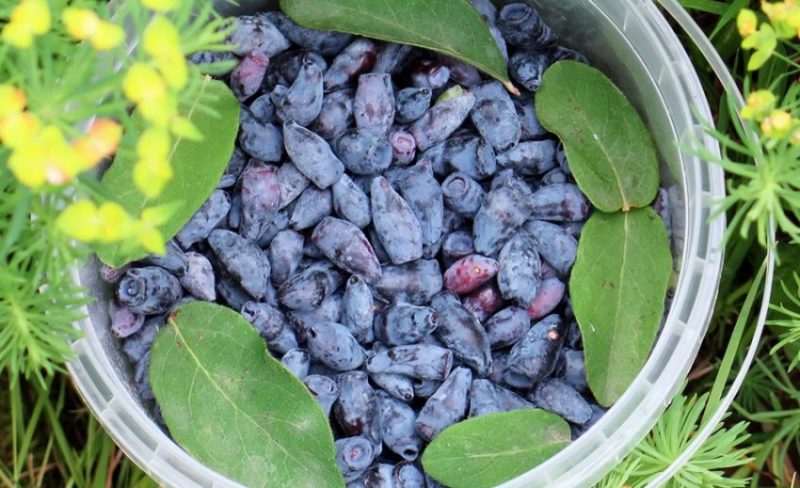
Honeysuckle of this variety is an upright compact bush of medium height (1.5 m). It reaches 1.2 m in diameter. The plant gains vegetative mass very quickly.
Young branches are colored gray-green, later they become dark brown, the bark on them peels off. The shoots are densely covered with leathery matte dark green leaves. Their shape is lanceolate, pointed at the ends.
Indigo Jam blooms profusely from mid-May. At this time, the bush is covered with many pale pink buds that resemble droplets. As the petals bloom, they become lighter in color. Inflorescences, consisting of 2 flowers, are formed in the axils of the leaf blades.
Honeysuckle berries are smooth, oval in shape, reminiscent of an elongated plum. The color is dark purple, the average weight is 1.9 g. The fruit pulp is dense, slightly elastic, and has a jelly-like consistency. At the ripe stage, the berries are sweet with a slight sourness and a pleasant tonic taste without bitterness.
Features of application
Indigo Jam honeysuckle berries are very sweet, so they are enjoyed fresh. Delicious fruits are used to make jelly, compotes, mousses, preserves, jams, various desserts, baked goods and wine.
The beneficial properties of berries are well preserved when frozen and dried, so they are prepared for the winter to supply the body with vitamins. In autumn and winter they serve as filling or decoration for pies and cakes.
Fruits contain many vitamins and other beneficial substances for the body. Thus, in terms of the concentration of ascorbic acid, honeysuckle competes with lemon, and it contains more iron than apples. Due to their many beneficial properties, berries are often used in folk medicine and cosmetology.
Productivity and fruiting
Honeysuckle is a fast-growing crop. Seedlings grown from cuttings usually begin to bear fruit already 2 years after planting.
The variety is characterized by high yields - 4-4.5 kg per bush per season.
Ripening period
Indigo Jam fruits reach ripeness in the second half of June. The harvest will be extended until early August, as the berries ripen unevenly.
Important! When there is insufficient lighting, honeysuckle berries become smaller and become sour.
Resistance to diseases and pests
The culture has strong immunity, therefore, with proper care, it is not susceptible to diseases and pests. But for the purpose of prevention, especially if the weather is humid for a long time, honeysuckle foliage and the soil under it are dusted with wood ash or tobacco dust.
Some gardeners treat shrubs and tree trunks with a 1% solution of copper sulfate as a preventive measure.. Spraying is carried out 2 times per season: before the buds swell and 3-4 weeks before frost.
Resistance to cold and drought
The variety is highly resistant to frost and cold. Without shelter, the plant easily tolerates temperatures down to -35°C. This determines the annual yield of honeysuckle.
Even flowers and ovaries remain unharmed during spring frosts down to -8°C. The only thing that can harm the crop in winter is a prolonged thaw. In such conditions, the plant leaves the dormant stage too early.
Honeysuckle tolerates short droughts well. During such periods it is watered rarely, but abundantly.
Suitable regions and climate requirements
Since the honeysuckle variety Indigo Jam is winter-hardy and easily tolerates cold snaps, it is suitable for cultivation in all regions of the country, but is recommended for cultivation in the Ryazan region and the Moscow region. Here the crop feels most comfortable, and therefore the yield rates are higher.
Advantages and disadvantages
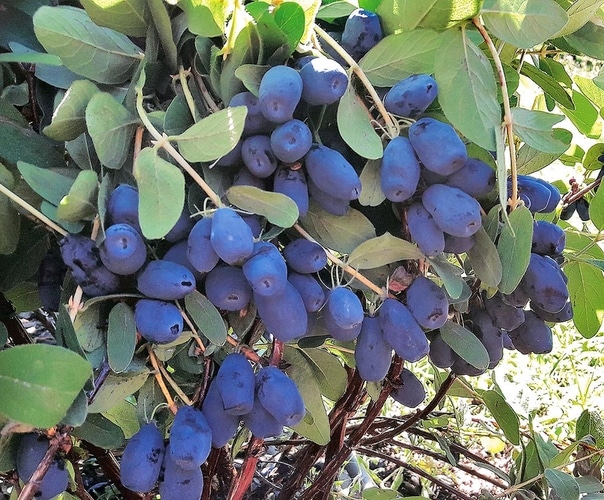
According to reviews from gardeners, honeysuckle has the following benefits:
- high performance;
- early pregnancy;
- non-shattering of berries until drying, dry tearing;
- high frost and drought resistance;
- unpretentiousness in care;
- excellent taste and universal use of berries.
The only drawback is the need to plant other varieties for additional pollination.
Difference from other varieties and hybrids
Indigo Jam differs from other honeysuckles in that the ripe berries do not fall off for a very long time.
In many other varieties and hybrids, they fall to the ground at the slightest breath of wind. This feature makes it possible to harvest using machinery, which is very convenient when growing a large number of bushes.
Agricultural technology
If you care for honeysuckle bushes properly, they will remain productive for many years..
One of the most important agrotechnical stages is planting.
Choosing a place in the garden and preparing holes
Choose the most illuminated place. It is also important to ensure that the site is protected from drafts and strong winds. Taking into account these requirements, the best place will be the southern side of the site, protected from drafts from the north.
The wells are prepared in advance. They are dug up 20 days before planting. The depth and diameter should be about 40 cm.
Preparing for landing
Seedlings begin to be prepared a day before planting. Plants are taken out of containers and the roots are freed from the ground. After this they are washed with water.
The seedlings are carefully inspected and dried shoots are removed, if any. Roots longer than 30 cm are shortened. Then the rhizomes are soaked for 20 hours in a growth accelerator solution.
Soil requirements
Honeysuckle Indigo Jam is not picky about soil. The main thing is that the soil is neutral or slightly acidic. The best yield is observed on fertile and light soils.
Dates, scheme and rules of planting
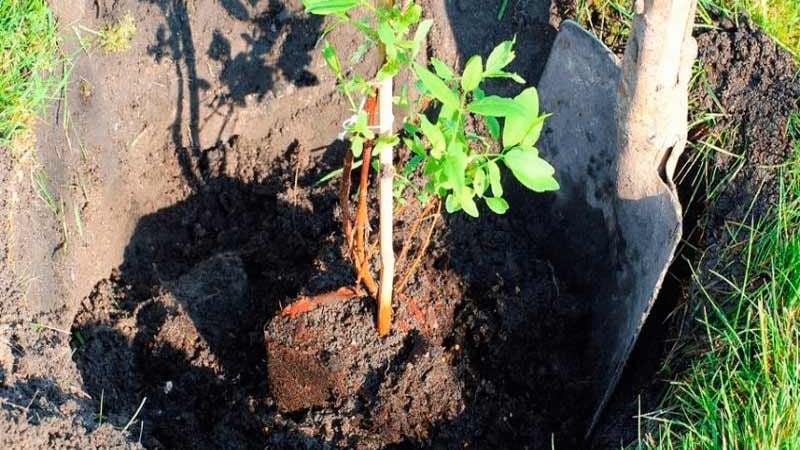
Planting in spring is carried out only in the southern regions. In all other cases, the procedure is performed in early September.
The bushes are arranged in a circle to achieve good cross-pollination. The distance between plants is maintained at approximately 1.5 m.
Landing instructions:
- The soil from the hole is mixed with 20 kg of compost and 1.5 kg of ash.
- The resulting substrate is filled with a third of the planting hole. A hill about 15 cm high is made in the center.
- Place the seedling on a hill and cover it with soil.
- After this, the plant is watered and mulched.
Features of cultivation
With a lack of sunlight, the berries become small and sour. Watering is also important. If there is little moisture, the berries will be bitter.
The main care activity is watering. Indigo Jam is watered once every 2 weeks with three buckets of water. Young plants are watered with 1 bucket of water every week. The next day after watering, the soil is loosened and mulched.
They begin to feed honeysuckle in the second year after planting. In early spring, 1 bucket of rotted manure is added under each bush. After flowering, fertilize with 0.5 kg of wood ash. In autumn, 50 g of superphosphate and 30 g of potassium salt are added to each plant.
Sanitary pruning is carried out every autumn. Cut off all damaged, broken, thickening, dry and creeping branches. Anti-aging pruning is required for bushes older than 10 years. Remove all shoots that have stopped bearing fruit.
Pollinators
The variety is partially self-fertile, so cross-pollination is very important for it. Since the yield of the harvest is extended (until the beginning of August), for a productive and long-term harvest of berries, it is desirable that the honeysuckle grows in a group consisting of 2-5 bushes of different varieties with different flowering periods: early, middle and late.
Recommended varieties: Yugana, Dessert, Altai, Bakcharskaya Anniversary, Bakcharsky Giant.
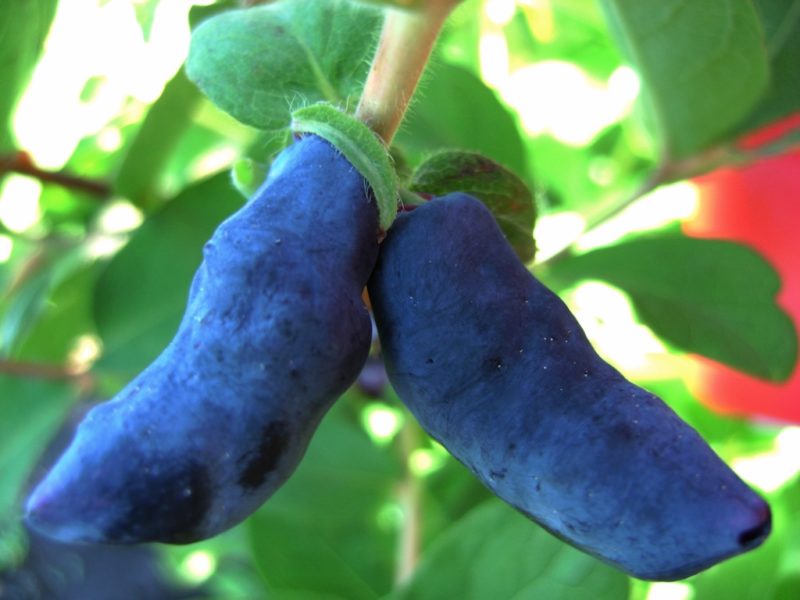
Disease and pest control
If the rules of agricultural technology are not followed, the crop can be affected by:
- Powdery mildew. A fungal disease manifests itself as a whitish or gray coating on the leaves and shoots of the plant. Over time, the bushes turn yellow and dry out. When the first signs of infection appear, all infected parts of the plant must be removed and treated with Fitosporin according to the instructions or with Oxychom (200 g per 10 liters of water).
- Aphid. To combat insects, gardeners usually dust the plantings with tobacco dust, loosen the soil in the rows and around the plants and replace the mulch with new ones.
Treatments against pests and diseases are carried out once a month.
Preparing for winter
This is a winter-hardy variety, so it does not require preparation for the winter period. They cover only young bushes in areas with a very harsh climate.
Reproduction
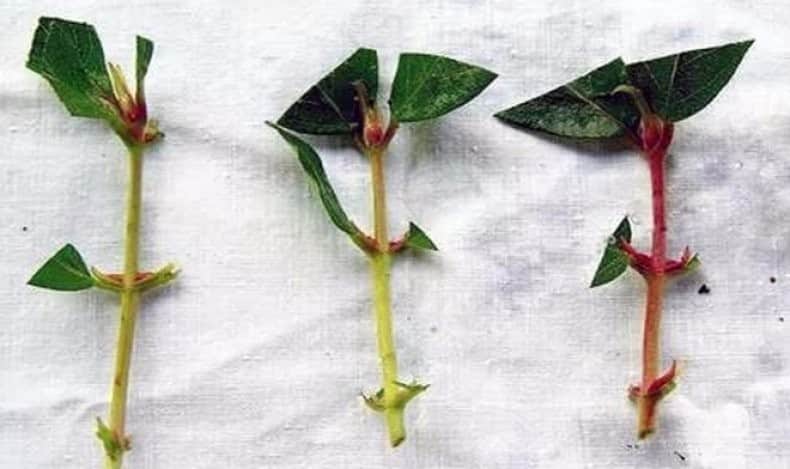
Reproduction carried out in three ways:
- Green cuttings. They are cut from the shoots of the current year during the formation of the ovaries. After this, the cuttings are soaked for a day in the Kornevin solution, and then planted in containers with nutrient soil. Cover the top with bottles. The shelter is periodically removed for ventilation.
- Lignified cuttings. Harvesting is carried out in early October. Cut the current year's growths into pieces with 2-3 internodes. Then they are wrapped in paper, buried to a depth of 10 cm and sprinkled with leaves. Plant in spring, leaving 1 internode underground.
- Dividing the bush. The plant is dug up in early spring and divided into several parts. After this, they are planted in different places.
Difficulties in growing
This variety is already known for its unpretentiousness.Gardeners usually do not encounter difficulties or any problems during cultivation.
Harvesting
Berries are picked as they ripen. In the container they should lie in one layer.
The fruits are harvested from late June to early August. In private farms, harvesting is carried out manually; when grown on an industrial scale, it is done using a mechanized method.
Tips and reviews from experienced gardeners
Gardeners love the Indigo Jam variety due to its sweet berries, resistance to diseases and temperature changes.
Evgeniya, Krasnodar: “I really like the Indigo Jam variety, but it has a drawback. Young plants have small berries. The aroma and taste are good, the berries are juicy. Honeysuckle is unpretentious in care. For every 3-4, Jema planted 1 pollinator. I'm satisfied with the result."
Tatyana, Ryazan: “Indigo Jam is a very worthy variety of honeysuckle. Its taste is also attractive because the skin of the berries is thin. The culture is not picky, resistant to diseases and frost. The berries gradually change in taste throughout the season. The sweetest ones are the last ones. I propagate the variety myself, and then give seedlings to friends.”
Conclusion
Honeysuckle Indigo Jam is a unique plant with excellent characteristics. With proper care, the bushes produce abundant harvests for many years. The main thing is to choose a suitable planting site and water the plant regularly.